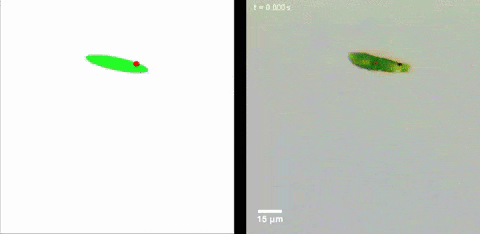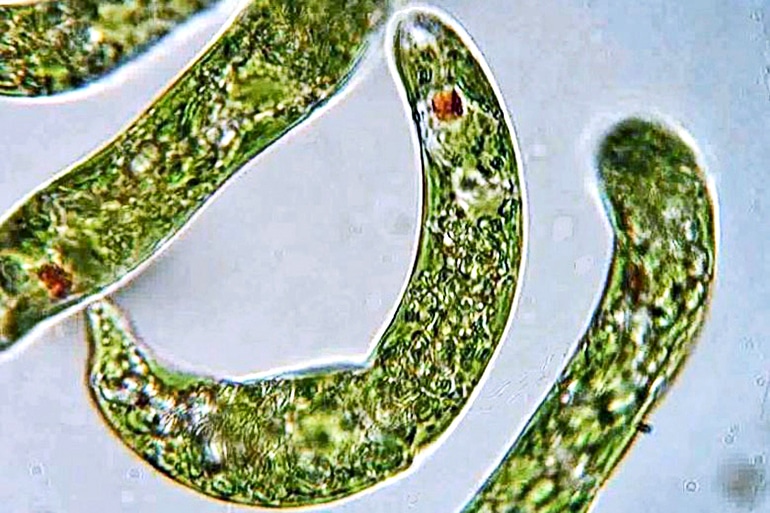Under some circumstances, single-cell organisms called Euglena gracilis halt their forward progress and begin tracing out elaborate triangles, squares, and pentagons in a mathematically defined effort to find a better environment.
The way Euglena traces polygons could help researchers design swimming robots that are more efficient at maneuvering through the bloodstream or navigating watery environments.
The still waters of any seemingly quiet pond actually teem with these tiny pond dwellers. Unseen to the naked eye, they spiral through the water, a whiplike appendage pulls them along a relatively straight path in search of just the right level of light.

“We’re trying to understand biological systems in a mathematical way,” says Ingmar Riedel-Kruse, assistant professor of bioengineering at Stanford University. “Seemingly simple feedback loops in single cells can actually generate rather complex behaviors in order to accomplish various tasks.”
Navigation know-how
Scientists in the 1800s once marveled at finding Euglena—a greenish oblong with a red eyespot and long, whiplike flagellum for swimming—under a microscope. Since then, countless generations of biology students have observed the organism.
With such a history of being watched, it came as a surprise when postdoctoral fellow Alan Tsang first noticed Euglena’s behavior in a computer model he’d developed to study how it moves in relation to light. In his model, when he simulated increased light, the organism began tracing out polygons.

Riedel-Kruse remembered being skeptical when Tsang first described what his model predicted.
“It was hard to believe that it’s true,” Riedel-Kruse says. “I thought there was something wrong with the code.” But when the pair checked under the microscope—increasing light levels as in the simulation—there were the polygons.
Birth of a triangle
The shapes are a result of how Euglena navigates the world. Because the organism normally rolls through the water on its long axis, the eyespot rotates to survey 360 degrees of light. In steady light conditions—which is normal under a microscope—it meanders along in a relatively straight path.
However, if the eyespot detects increased light intensity, Euglena makes a hard turn, Tseng says.
“Then they don’t see the light and they swim straight again,” Riedel-Kruse says. “But since they keep rolling, then after a full cycle they see again the strong light so they make another strong side turn.”
Enough straight lines followed by sharp turns and a triangle is born.
Tsang noticed that over the course of about 30 seconds, Euglena adapted to the stronger light and the turns became less sharp, creating ever-expanding polygons—squares, then pentagons—until, finally, the Euglena headed in a relatively straight line.
As for why nobody had seen this before, people rarely alter light levels while observing Euglena under a microscope, according to Riedel-Kruse. But since Tsang was specifically trying to model how the organism moves in relation to light, he did something unusual and the behavior appeared.
Tiny robots
The behavior makes sense for a Euglena swimming along in a pond under a comfortable source of shade, argues Riedel-Kruse. When it suddenly encounters bright sunlight it can turn quickly to seek a patch of shade. By slowly spiraling outward if the first few turns didn’t work, the Euglena ups its chances of eventually getting out of the sunlight.
Riedel-Kruse’s lab studies Euglena in part to better understand how microorganisms navigate their watery worlds. The researchers also integrate what they learn about Euglena into interactive biology setups for education. Euglena is an unusual organism that can both make its own food and eat what it finds in the water. It is related to plants, animals, and fungi—all known as eukaryotes—but is a separate group with some unique characteristics.
“Because it is part of an outgroup to most eukaryotic life, you could learn something that is general, and you can also find out how diverse eukaryotic life can be,” Riedel-Kruse says. “That makes Euglena really interesting to me.”
What’s more, Riedel-Kruse and Tsang say what they learn—and the mathematical models they develop—could be useful for microscale robotics.
“There is an emerging field where people are trying to engineer and program microscopic swarm robotics for things like microsurgery or drug delivery,” Tsang says. “I definitely see people looking for efficient control mechanisms at the microscale.”
The research appears in Nature Physics.
Source: Stanford University

